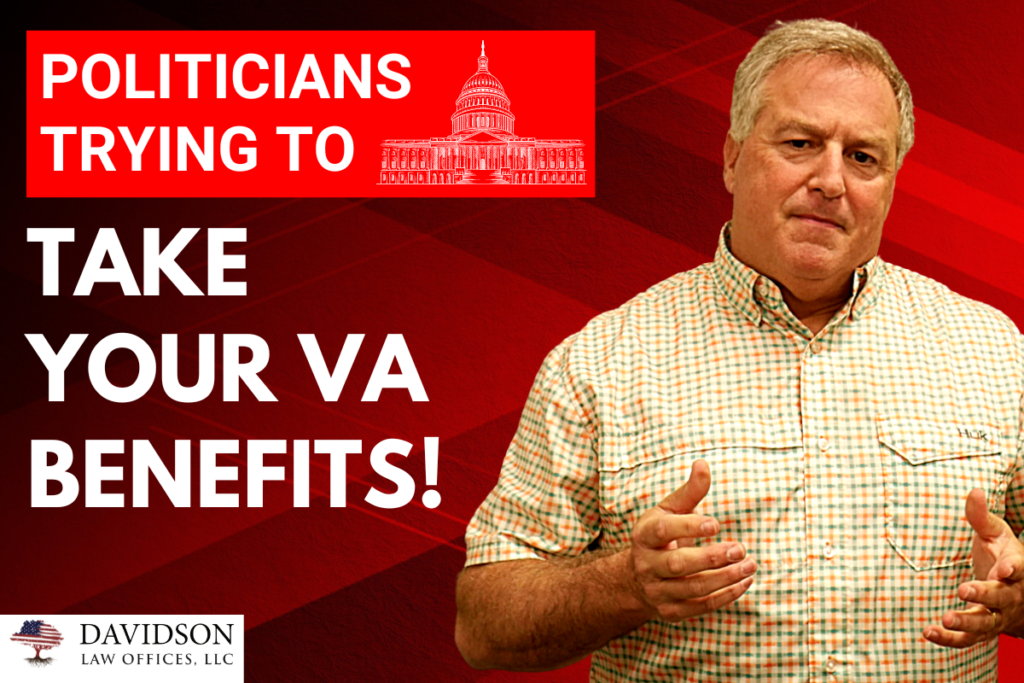In this blog I wanted to follow up on a recent YouTube video that discusses how recently proposed budget cuts could affect Veterans benefits. We’re not trying to use this information to create fear amongst Veterans, but we do want to educate everyone as to what’s happening in Washington DC. We want to inform Veterans how these politicians and bureaucrats could affect their disability benefits. This is about education, not fear mongering.
The Congressional Budget Office is giving Congress options to reduce the deficit. The deficit is now around $16 trillion, which is an outrageous amount of money. And many want to blame Veterans programs for the deficit spending, but they’re failing to recognize some key facts that we’ll discuss below.
Reckless Spending Increasing the Deficit
Let’s first discuss how spending has increased across a wide range of government programs. Recently there has been $132 billion spent on mandatory programs such as Social Security, Medicare, and Medicaid. That’s an 11% increase. I’m not criticizing those programs or saying we shouldn’t be dedicating funds to those programs. I’m just stating the facts. We also have a $90 billion or 41% increase in the net interest payments on our $16 trillion debt.
There has also been a $53 billion or 75% increase from Department of Education programs. This was mainly due to the cost of extending the moratorium on student loan payments during COVID. While I understand that people needed help during the shutdown, it’s time for people to start paying back their student loans. Don’t put that on the tax payers.
Then we have the $29 billion that was paid to the FDIC as a result of the Silicon Valley Bank that recently went bankrupt. That money is being used to bail out that situation. We could argue for days over the necessity of all that spending, but I wanted to use those as examples of percentage increases for certain programs.
Spending for Veterans Programs
Now let’s look at the spending for Veterans programs compared to those numbers. Over the past five years, the VA has handled around 5 million Veterans cases. The average payout is $19,439 per year per Veteran which has seen a 6.5% increase. For survivors or dependents, the VA handled around 440,000 cases with an average payout of $18,400 per year. For those situations, there has been a 7% increase over the last five years.
As you can see, that’s a signifiant amount of money being used for Veterans programs. But those increases are insignificant compared to the increases we’re seeing in other programs like Social Security, Medicaid, Medicare, and the Department of Education. As a result, blaming Veterans programs for the deficit is just plain dishonest. But luckily, the VA Secretary is on the side of the Veterans.
Make no mistake though, there is a push to reduce funding for Veterans programs. This push is mainly focused on reducing VA disability payments through means-based testing and making it harder to qualify. Means-based testing would disqualify some Veterans based on their household income.
Means-Based Veterans Programs
Under the CBO recommendations, disability compensation would decrease $1 for every $2 of gross total household income. Under the phase-out, Veterans whose household income was over $170,000 could see their disability benefits reduced or eliminated. The fact that they’re disabled because of their service is completely ignored. The government says that they make too much money to be compensated for their disability. That is absurd!
One of the big problems with having means-based disability compensation is that there is no adjustment to the income threshold for household size. The $170,000 threshold mentioned earlier is for everyone in the household. If you have a spouse that makes $100,000 a year and a couple kids making $40,000, you would be automatically disqualified for benefits from Veterans programs. That’s not fair.
The CBO proposal also doesn’t consider cost of living in different parts of the country. For example, it costs much more to live in Los Angeles as compared to Huntsville, Alabama. These new recommendations don’t take into account the disparities between the cost of living in those areas. Research indicates that someone with a disability has a 28% to 30% higher cost of living, and this should certainly be considered in these new CBO recommendations.
If you’re disabled, your housing is going to be more expensive because you’ll need certain physical alterations to the home. You may need a ramp, pull bars, lowered kitchen cabinets, etc. All of these additions or renovations to a home can be very expensive. Maybe you need a chair lift installed in your van? That’s not cheap either! Also, if you live in a small town you may not have the luxury of InstaCart and other delivery services. As a result, you’ll pay more to have necessities of daily living delivered to your door.
The Number One Reason to Preserve Veterans Programs
All of the above mentioned points are great examples of why these CBO recommendations are bad for Veterans. But the number one reason these recommendations are concerning is that these Veterans were injured on the job. They were injured while serving our country. Sometimes they were injured by the enemy, but often times they were injured by our government.
Veterans put their lives and health on the line to keep us safe. We don’t need to abandon them now that they need our help. We need to talk to our Congress members and stress the importance of maintaining funding for these Veterans programs. Without our Veterans, we might be speaking a different language.
All Veterans deserve disability pay if they have a service-connected injury. It shouldn’t matter how much money they make. There is always going to be someone in a worse condition than you, but all Veterans deserve disability compensation for their service-connected injuries. If you served our country and kept us free, it’s our duty to take care of you now and provide disability compensation.
Contact Us So We Can Help!
If you need assistance with applying for VA disability benefits, you can complete this form or give us a call at (229) 226-8183. If you’d like to see this blog in video format, you can watch it below. Please be sure to SUBSCRIBE to our YouTube channel and click the bell notification button so that you’re notified each time we publish a new video.

